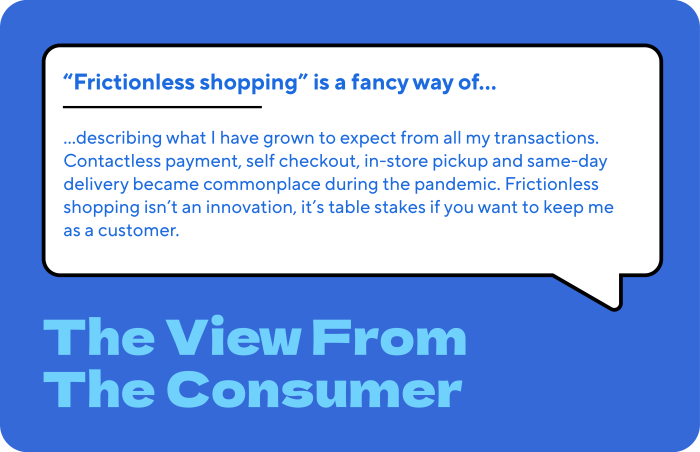
It’s no secret that the retail industry is in a state of flux. The rise of eCommerce, changing preferences of consumers, and rapidly changing technology have fundamentally altered the way retailers do business. One of the most significant trends reshaping the retail landscape is the move toward “frictionless shopping”.
New approaches to frictionless shopping
Frictionless shopping is a customer experience that is seamless and convenient. It’s all about removing any obstacles that might stand in the way of a customer making a purchase. That might seem like common sense to any retailer, but there are a host of new approaches to creating a frictionless shopping experience. Some of the most common methods include:
- Self-checkout: Self-checkout kiosks allow customers to scan and pay for their own items, without having to wait in line at a traditional checkout counter.
- Contactless payments: Customers now expect to be able to pay for their purchases using their mobile phone or a contactless payment method. This eliminates the need for cash or credit cards, and it makes the checkout process much faster and more convenient.
- Click-and-collect: Click-and-collect allows customers to order items online and pick them up in-store at a time that is convenient for them.
- Endless Aisle: Customers can now use their mobile phones to browse the in-store and online inventory to understand real-time product availability. This allows them to make informed decisions about what to buy and when they will get the product.
- In-store pickup: In-store pickup is similar to click-and-collect, but it allows customers to order items online and have them delivered to their local store for pickup.
- Same-day delivery: Same-day delivery allows customers to order items online and have them delivered to their home or office the same day.
- Virtual reality/augmented reality: Virtual reality and augmented reality can be used to create immersive shopping experiences that allow customers to see and interact with products before they buy.
Frictionless shopping is a great example of how retailers can leverage technology to form deeper relationships with their customers. Brands need to understand how complex touchpoints and emerging technologies impact their consumers’ experience to stay competitive in the post-pandemic retail landscape.

The incentive to use these technologies isn’t just a matter of retaining customers either. Frictionless shopping technologies can also save retailers money on labor and overhead costs in a tight market. If this piques your interest, learn more about how KWI’s partnership-driven approach is helping retailers stay ahead of the game.
Consumer patience is waning. The time is up.
The shopper journey has changed as retail tech has evolved. Nearly 80% of customers now use their mobile devices to shop. E-retail giants like Amazon have pushed the retail industry to embrace frictionless technology just to keep up with customers’ shopping experiences and expectations. These tech-enabled use cases have become so ubiquitous that retailers who have been slow to adopt new technologies have rapidly become irrelevant.
Consumer patience with the retail industry is running short and there is a critical need for retail to evolve – or risk losing previously loyal customers to those who provide a better experience.
So…. where did things go wrong? The list of potential “friction points” in the shopping experience is almost too long to count. Retailers today are struggling with everything from staffing to inventory management – much of which is compounded by inefficient omnichannel retail strategies (the wrong tech, in the wrong places).
A complicated shopper journey has led retailers astray from key customer service principles:
- Responsiveness: Customers expect retailers to respond to their inquiries and requests quickly. This means that retailers need to have a customer service team that is available to answer questions and resolve issues quickly.
- Accuracy: Customers expect retailers to have accurate information and to process their orders correctly. This means that retailers need to earn a reputation for accuracy and quality control.
- Empathy: Customers expect retailers to be understanding and empathetic when they have a problem. This means that retailers need to have customer service representatives who are patient and who are able to put themselves in the customer’s shoes.
- Personalization: Customers expect retailers to personalize their shopping experience. This means that retailers need to collect data about customer preferences and use that data to make recommendations and offer personalized deals – in-store and online.
Customer service principles alone won’t carry the day, however. Retailers still need to invest in the right technology, and they need to train their employees to use it effectively. They’ll also have to continue to elevate consumer-facing design principles to make it easier for customers to find what they are looking for.
Frictionless tech solutions (like those offered as part of KWI’s platform) can serve as a force multiplier by providing a consistent omnichannel experience for their customers. This means customers can shop online, in-store, or via mobile while enjoying the same service and convenience across each platform equally.
Optimizing the shopping experience
As retailers look to emerging technology to improve the customer experience, their relationships with their IT teams are evolving. Friction between retail operations teams (who want to provide an optimal experience) and IT teams (who prize stability and performance) has become an increasingly common pain point. There’s an obvious need for more partnership and collaboration between these teams if technology is to be effectively implemented to meet the needs of both customers and employees.
Retail IT teams need to emphasize customer-focused agility to respond quickly to changing customer expectations, and that requires a deep understanding of the customer journey and the friction points that technology can address. By working closely with marketing and operations teams (to name a few), IT teams can integrate technology seamlessly into the overall customer experience. This means partnering to redesign customer journeys and continually optimizing the shopping experience to meet the changing needs of customers.
As retailers look to stay competitive in a rapidly changing marketplace – strategic technology investment (and successful deployment) is critical.
Do you have questions about how to evolve your retail tech stack? Contact us today and let us put our 37 years of retail tech experience to good work. KWI’s unified commerce platform provides you with customizable tools that allow you to streamline customer experience – and our partnership-focused approach to customer success means that you can focus more on your customer, and less on headaches.